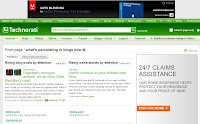I can see the most popular bookmarks on Delicious's home page. Hence, I can see what other people are most interested currently. It's also very convenient to save the links listed on the first page as my personal bookmark. But unlike Diigo, delicious can't add Sticky Notes or highlight information on a web page.
 CiteULike doesn't have that annotation features as Diigo, either. But I think one of the advantage of CiteULike is that it has a citation management feature. I can choose different citation formats and see the abstracts of the articles. This is more useful for researchers, who need to collect academic articles, cite reference, and write papers. I can see other people's bookmarks and tags on the CiteULike's home page. Through other people's bookmarks, I can even connect to ERIC database to find more relative articles that I may be interested in. I feel CiteULike will be beneficial for me because of its citation management features and I still need to explose it more.
CiteULike doesn't have that annotation features as Diigo, either. But I think one of the advantage of CiteULike is that it has a citation management feature. I can choose different citation formats and see the abstracts of the articles. This is more useful for researchers, who need to collect academic articles, cite reference, and write papers. I can see other people's bookmarks and tags on the CiteULike's home page. Through other people's bookmarks, I can even connect to ERIC database to find more relative articles that I may be interested in. I feel CiteULike will be beneficial for me because of its citation management features and I still need to explose it more.An introduction to CiteULike, CiteULike: a researcher's social bookmarking service (Emamy & Cameron, in Ariadne) .




